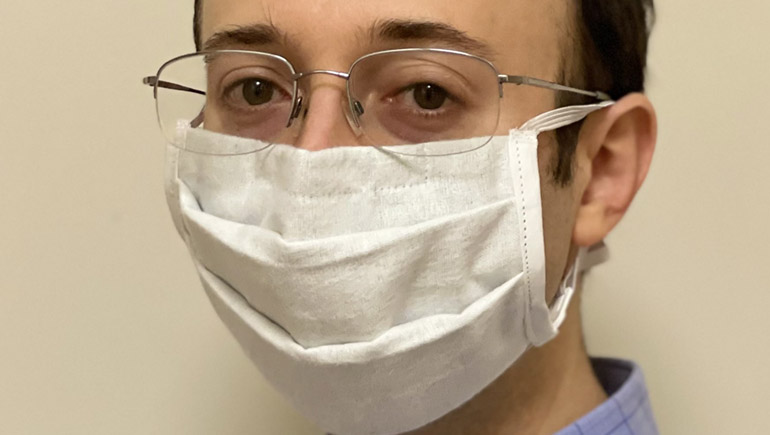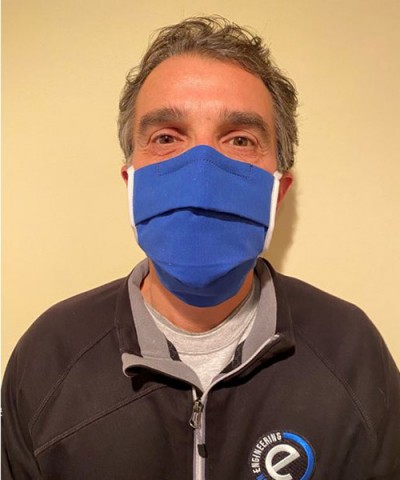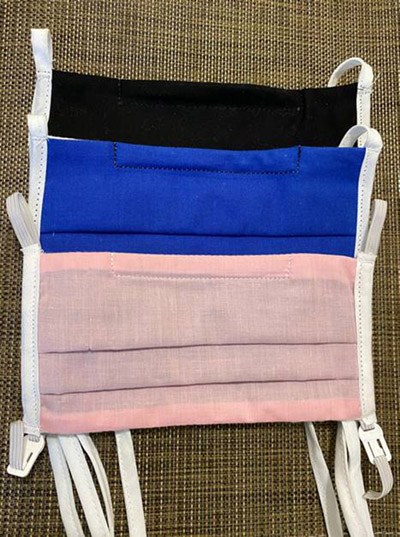Watson professor and his students team with Intuitive Surgical for mask research
Extensive testing determined the most effective materials that would block the coronavirus

In early 2020, Assistant Professor Scott Schiffres never imagined that he would spend part of the year researching the effectiveness of facemasks against viruses.
As a faculty member in the Department of Mechanical Engineering at Binghamton University’s Thomas J. Watson College of Engineering and Applied Science, he generally focuses with his students in the Nano-Micro Thermal Group on heat transfer, additive manufacturing and related topics.
But when COVID-19 reached U.S. shores last March, Schiffres wondered how to make the most effective mask that would block the coronavirus. He started doing tests with materials he had around his house or could purchase at local hardware stores, using a particle analyzer that he borrowed from Watson College’s cleanroom. To document his findings, he recorded and posted videos to YouTube.
Then Intuitive Surgical contacted him. The company, best known for designing and manufacturing da Vinci medical robots, wanted to make masks not just for its employees but also to donate to medical professionals and communities in need through its sponsored charity, the Intuitive Foundation. They wanted to ensure they made the best masks possible.
That’s how Schiffres connected with Scott Manzo, Intuitive’s managing principal engineer in Connecticut, and started a long-distance collaboration from Binghamton.
“Neither of us had worked on face masks before, but we knew how important it was to get it right,” Schiffres said.
When COVID started spreading around the U.S., Intuitive’s mask distribution plan was driven by both altruism and necessity. Some engineers had family members who worked in intensive-care units but lacked proper personal protective equipment (PPE) to filter out the virus.
“We started making face shields to support the local hospitals in Connecticut,” Manzo said. “Whatever material we could find — we were 3D printing frames and doing what we could. As the need started to grow, we started making masks from do-it-yourself directions, and we found a little army of people who could sew masks for us.”
The Intuitive Foundation reached out to Manzo to develop and procure masks at a much larger scale. Manzo and his colleague in California, Iman Khalaji, cold-called Schiffres after seeing one of his videos online: “There was a disclaimer on the video that he was just figuring things out. We were doing the same, and I thought we could figure it out together. He had the university resources, and I had my company resources. We had some smart folks who were willing to do it, so we thought, ‘Let’s make it happen.’”
Setting up in his garage, Schiffres got to work with students Morteza Bagheri, PhD ’20; PhD student Arad Azizi; Natalia Basauldo ’20; and Rebecca Loibl ’18, MS ’20. They used the particle analyzer loaned to them by Shawn Wagoner, director of Watson College’s Nanofabrication Lab, as well as other equipment from senior scientists Anju Sharma and In-tae Bae at Binghamton’s Analytical and Diagnostics Lab.
The team started with a material called sterilization wrap, which is used when medical equipment needs to be sterilized.
“It’s obviously known to be good as a filter, because it allows the steam to sterilize the equipment but blocks bacteria. We also tried to balance whether it was washable,” Schiffres said. “So we tested a bunch of different fabric combinations with sterilization wrap and different grades of sterilization wrap, and it just grew from there. Every few days, I’d get a different package of fabric samples from California and Connecticut.”
As part of the research, fabrics went home with members of the research team as well as Intuitive employees who would wash them with their laundry and return them for retesting to see if effectiveness changed and by how much. Some swatches went through 10 or more washing cycles.
The masks that Intuitive distributed — 300,000 in all — went through different iterations, each design using the most current research findings from Schiffres and his team. The best combination: soft flannel on the inside for comfort, thin-as-possible cotton on the outside, and a filter in the middle.
“One of the challenges was finding a steady supply of material — enough that we could make even 5,000 masks, let alone 300,000. Everybody wanted them,” Manzo said. “We’d find a supplier and then it would be canceled. I would have to send Scott a new sample and start testing all over again.”
Even though it is not yet published, pre-print distribution of the project’s findings already has gained attention, including a citation by the Centers for Disease Control and Prevention’s mask guidance.
Although the research is not one that Schiffres had planned to pursue, he sees it as an important contribution in the fight against COVID-19.
“I had never worked with medical doctors on a research paper before,” he said. “It was a very good experience, and I learned a lot about COVID and how flu viruses are transmitted. We found many papers about disease transmission that I never thought I’d read.”
Manzo has nothing but praise for Schiffres and his Binghamton team: “Scott and his students were incredible — just amazing. We had so much fantastic data, and they were just on top of everything. Everybody wanted to contribute, so we did a lot of work in a very short time.”
The study from Manzo, Schiffres and his students, “Filtration Efficiency, Breathability, and Reusability of Improvised Materials for Face Masks,” will be published in Aerosol Science & Technology.


